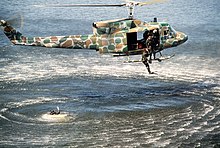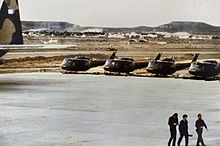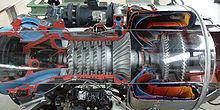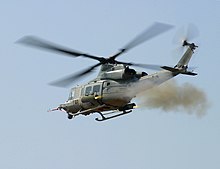Bell UH-1
| Bell UH-1 Iroquois | |
|---|---|
 UH-1D of the German Air Force |
|
| Type: | Light multipurpose helicopter |
| Design country: | |
| Manufacturer: | |
| First flight: |
October 22, 1956 |
| Commissioning: |
1959 |
| Production time: |
in series production since 1958 |
| Number of pieces: |
approx. 16,000 |
The Bell UH-1 Iroquois (often simply called the Huey ) is a light, multipurpose helicopter developed by Bell Helicopter for the US Army . The helicopter was the US armed forces’s first turbine-powered helicopter . Originally designed as a helicopter for evacuating the wounded , it was modified for other tasks during its long service life. The helicopter was first used in the Vietnam War . Over 16,000 units of the UH-1 family were built.
The name Huey resulted in an allusion to its original name HU-1 , which was changed in 1962.
history
In February 1954, the Army wrote a design competition for a turbine-powered multipurpose helicopter that was to be used in the Medical Corps . A helicopter was required that could carry a payload of 363 kg (800 lb) over a distance of 185 km (100 nm). It should still be easy to maintain and loadable with the cargo planes of the time (e.g. the C-124 Globemaster II ). The Lycoming T53 freewheel turbine was to be used as the drive .
Based on the experience with the development of the H12 - cell , constructed Bell model 204, which won the competition and by the US Army the designation XH-40 received. In May 1955, Bell received the order to build three prototypes (serial numbers 55-4459 to 4461). The corresponding engineering work began in June 1955, on October 28th the dummy could be viewed and a short time later the construction of the prototypes began. Less than a year after construction began, the first flight of the first XH-40 took place on October 22, 1956, followed by the other two prototypes in February and June 1957.
With a contract dated October 19, 1956, Bell was commissioned with the production of six prototypes YH-40, which should be used for field testing. This was followed by nine pre-series machines, which were given the designation HU-1 (H for helicopter , U for utility , German multi-purpose helicopter) in the Army system valid from 1956 to 1962 . The string HU-1 resulted in the nickname "Huey" used by GIs. The helicopter was officially named " Iroquois " in accordance with the practice of naming Army aircraft after Indian tribes .
On June 30, 1959, the first HU-1A series aircraft was delivered to the 101st Aviation Battalion. The 56th and 57th Medical Detachment (Helicopter Ambulance) also received their machines at this time to test the originally intended purpose, medical evacuation. In 1962 the name was changed to UH-1 in the course of standardizing the individual systems of the Air Force, Navy and Army.
The Huey became famous for its missions in the Vietnam War , where it was used for almost any purpose, including close air support , although it was not actually designed for that. The loss rate was correspondingly high: of the more than 7,000 Hueys deployed in Vietnam, only 2,000 returned after the end of the war - but several hundred were abandoned, destroyed or handed over to the South Vietnamese army when the US troops withdrew .
In the US Army, the UH-1 has now been almost completely replaced by the UH-60 Black Hawk . Most of the Army's remaining UH-1s were mothballed by September 2004 when Army technical assistance ended. In April 2008 there were still about 60 Hueys in the Army and 70 in the US National Guard , which were only held for special tasks. The United States Marine Corps (USMC) continues to use the UH-1Y and ordered 18 units in June 2010, including some AH-1Z .
The US National Guard officially decommissioned the Bell UH-1 helicopter on October 2, 2009 after 50 years of service. In the US Army, too, the remaining machines, as in the National Guard, are being replaced by the UH-72A Lakota . The last four US Army UH-1s stationed in Europe were decommissioned at the Joint Multinational Readiness Center (JMRC) in Hohenfels at the end of April 2011 after almost 40 years of service in Europe. As the last major armed force, the US Air Force will replace its UH-1, which is still in operation, with a further developed military version of the AgustaWestland AW139 , the MH-139.
Series and versions

Single engine
Bell 204
- UH-1A
- First series version with 860 WPS with Lycoming T53 L-1 turbine. The helicopter was originally called the HU-1A , hence the (unofficial) nickname Huey .
- TH-1A
- 14 UH-1A converted into trainers.
- XH-1A
- a UH-1A equipped with a grenade launcher for experimental purposes.
- UH-1B
- Version with 960 WPS T53-L-5 turbine. The rotor was enlarged to 13 m in diameter and the rotor blades to 53 cm wide. The cabin was enlarged for up to seven men or three stretchers. 1010 copies were delivered to the US Army.
- UH-1C
- Version with 820 kW (1100 WPS) T53-L-9 or L-11, 69 cm wide Bell 540 rotor blades, the stern has also been lengthened for improved maneuverability. The fuel load was increased and an additional hydraulic double control (for improved fire tolerance) introduced. 756 copies were delivered to the US Army, five to Australia and five to Norway.
- UH-1M
- UH-1C retrofitted with 1000 kW (1400 hp) Lycoming T53 L-13 turbine.
- UH-1E
- For use on ships a navalized version of the UH-1B / C made of aluminum (for protection against corrosion) for the US Marine Corps. The first 34 corresponded to the UH-1B, the remaining 158 were navalized UH-1C. Many later received the Lycoming T53 L-13 turbine with 1000 kW (1400 hp).
- TH-1E
- 20 UH-1E delivered as a trainer for the USMC.
Bell 205
- YUH-1D
- Prototype of a 1.05 m longer version with space for 13 passengers or 6 stretchers. The prototype was equipped with a T53-L-9 turbine and first flew in August 1960.
- UH-1D
- Production version of the YUH-1D with 820 kW (1100 WPS) from the Lycoming T53 L-11 engine. 2561 UH-1D were built, 2008 of which went to the US Army. The helicopters of the Bundeswehr for the German Army and the German Air Force also carry the designation UH-1D, but were built according to the UH-1H standard (Lycoming T53 L13B engine, pitot tube on the cabin roof).
- HH-1D
- converted UH-1D with 190 l extinguishing tank for SAR operations and for fire fighting.
- UH-1F
- A version of the UH-1B initially designated as the XH-48A for the US Air Force with a 932 kW (1250 WPS) General Electric T58 turbine from the Sikorsky CH-3 of the USAF. 120 were built. Agusta built this version under license as the AB204B.
- UH-1H
- UH-1D with 1000 kW (1400 PS) Lycoming T53 L 13B turbine and pitot tube above the cabin. From 1967 the production was switched to the UH-1H, of which almost 8000 pieces were built for the US Army (4850) and other customers (often under license). 358 of this model were built by Dornier under license for the German armed forces, of which the Federal Border Police received six for “leadership and use”. They are used in the army and the air force, where they also serve in air rescue as search and rescue helicopters and in disaster control.
- EH-1H
- 22 UH-1H ("Project Quick Fix") converted for the use of electronic countermeasures .
- HH-1H
- 30 SAR helicopters for the USAF.
- TH-1H
- UH-1H converted into coaches for the USAF.
- HH-1K
- SAR version of the UH-1E for the United States Navy with different avionics and a Lycoming T53-L-13 turbine. 27 were built.
- UH-1L
- Version of the UH-1C with Lycoming-T53-L-13 turbine of the US Navy for use in Vietnam, 8 were built.
- JUH-1 SOTAS
- a UH-1H equipped with an AN / APS-94 radar.
- TH-1L
- Trainer version of the UH-1L for the US Navy, 90 were built.
- HH-1N
- SAR version of the UH-1N
- VH-1N
- VIP transporter.
- UH-1P
- armed UH-1F of the USAF (also for psychological warfare in Vietnam).
- UH-1V
- UH-1H of the US Army converted into SAR helicopters.
- EH-1X
- a UH-1H converted to use electronic countermeasures.
- Huey II
- Modified and refurbished former US Forces UH-1H for third countries, improvements include a new Allison T53 L-703 engine with 1.343 kW, new propulsion system components, new wiring and a refurbished airframe.
Twin engine
Bell 212
- UH-1N "Twin Huey"
The UH-1N Twin Huey is based on the twin-engine Bell 212 . It has two Pratt & Whitney Canada PT6T-3 / T400 turbo twin- pac turbines with 1342 kW (1800 WPS) for the US Navy, the US Marine Corps and the US Air Force (USAF). In April 2012, the USAF made a performance request to modernize the aging UH-1N. The aim is to be able to use the helicopter type for another 30 years. On October 1, 2013, the USAF announced that it would modernize the existing UH-1N and continue to use it for at least ten years.
Four-blade rotor
Bell 412
- UH-1Y "Venom"
Also called "Super Huey" . An improved version of the UH-1N based on the Bell 412 with modern avionics, glass cockpit , two General Electric T700 GE 401C turbines with each 1150 kW (1546 WPS) and a four-blade rotor. 113 new buildings and the conversion of 18 older machines are planned.
Military users

|
|
technology
In addition to “Huey”, “carpet beater” is also known as a nickname, due to the effect of the induced air resistance . On the rotor blades, air vortices occur at the blade tips, which leads to popping noises when the next blade passes through. The helicopter can be heard from about 10 km away - first as a low grumble that gets louder and louder, and then increasing popping noises when the helicopter is only about 1.5 km away. Since the introduction of blades with a new geometry in the 1990s, this effect has been significantly reduced due to the slimmer blades. Due to the angle of attack and the propulsion, the rotor blades of every helicopter perform so-called flapping movements ; the rotor blade moving forward in the direction of flight has the tendency to flip up, which leads to a reduction in lift. The rotor blade moving backwards in the direction of flight loses lift due to the backflow and hits downwards. The semi-cardanic rotor blade suspension of the UH-1 (typical for two-blade rotors) prevents rolling around the longitudinal axis. The typical Bell stabilizer dampens violent flapping movements of the rigidly interconnected main rotor blades and control inputs from the pilot according to the gyro principle.
Technical specifications
| Parameter | HU-1A Iroquois (Model 204) | UH-1H (205A-1) |
|---|---|---|
| Engine | a Lycoming T53-L1 (522 kW / 700 WPS ) | an Avco Lycoming T53-L-13 (1,044 kW / 1,420 WPS) |
| Top speed | 220 km / h (around 120 kn) | |
| Cruising speed | 177 km / h (110 mph ) | 165 km / h (90 Kts) |
| Range | about 338 km | about 507 km |
| Tank capacity | k. A. | 833 liters (666 kg) |
| Altitude | k. A. | 4,145 m |
| Hover altitude | more than 4,267 m (with ground uplift effect) | k. A. |
| Empty weight | k. A. | 2,140 kg |
| Take-off weight | 2,631 kg | 4,310 kg |
| Pilots | 1-2 | 1-2 |
| Passengers | 6th | Max. 12 |
| Hull length | 12.07 m | 12.77 m |
| overall length | k. A. | 17.41 m |
| Rotor diameter | 13.41 m | 14.63 m |
Technical data for the HU-1A Iroquois (Model 204) is based on Flight Magazin , 1960.
Armament
- Mounted internally on swiveling rotating ball mounts in the sliding door
- 2 × pivoting mounts for 1 × M23 weapon system each (2 × 7.62 mm US Ordnance M60D machine guns with 550 rounds of ammunition)
- 2 × pivoting mounts for 1 × 7.62 mm machine gun FN Manufacturing M240D GPMG (FN MAG-58 or C6) with 100 rounds of ammunition
- 2 × swivel mounts for 1 × 7.62 mm Rheinmetall MG3 (MG42 / MG59) machine gun with 120 rounds of ammunition
- 2 × pivoting mounts each for 1 × GAU-2A / B weapon system (also GAU-17A in the US Navy consisting of 1 × 7.62 mm Gatling machine gun General Electric M134 with 4000 rounds of ammunition)
- 2 × pivoting mounts for 1 × GAU-15 weapon system each (also GAU-16/18 / XM-213/218 in the US Army / USAF consisting of 2 × 12.7 mm Browning M2 machine guns with 100 rounds of ammunition)
The UH-1 can be equipped with two external stores support assemblies (ESSA for short) for externally attached weapons. Pivoting machine guns are mostly mounted on the ESSA. The first UH-1A had makeshift .30 MGs mounted on the runners, and MGs were also makeshift retrofitted in Vietnam at the level of the external load carriers or on the cabin floor. With the UH-1N / Y, MGs are mounted on the external load carriers (improved defensive armament system, IDAS for short) and rocket launchers or additional tanks are also mounted on the BRU-20 / A or BRU-21 / A suspensions.
- At two external load stations
- 2 × M26 launchers, each with 3 × Raytheon BGM-71A "TOW" - wire-guided
- Unguided air-to-surface missiles
- 2 × rocket tube launch containers LAU-61/19/261 or XM159 / 200 for 19 × unguided Hydra air-to-ground missiles each ; Caliber 68 mm / 2.75 inch
- 2 × rocket tube launch container HL-19-70 for 19 × unguided Hydra air-to-ground missiles each; Caliber 70 mm
- 2 × rocket tube launch containers LAU-260, LAU-68 or XM158 for 7 × unguided hydra air-to-ground missiles each; Caliber 68 mm / 2.75 inch
- 2 × XM-3 rocket tube launch containers for 24 × unguided FFAR air-to-ground missiles each; Caliber 68 mm / 2.75 inch
- 2 × rocket launch tube TBA 68-7 for 7 × unguided air-to-ground missiles SNEB ; Caliber 68 mm
- 2 × TBA 68-12C rocket tube launchers for 12 × unguided air-to-ground missiles SNEB; Caliber 68 mm
- 2 × rocket tube launch container TBA 68-22C for 22 × unguided air-to-ground missiles SNEB; Caliber 68 mm
- 2 × rocket tube launch containers TBA 100-4 for 4 × unguided air-to-ground missiles SNEB ; 100 mm caliber
- Additional container
- 2 × machine gun containers (X) M18A1 or SUU-11 / A , each with a six-barrel 7.62 mm Gatling machine gun General Electric M134 with 1500 rounds of ammunition
- 2 × machine gun containers SUU-12 / A (or XM14 in the US Army) each with a 12.7 mm M3 machine gun with 750 rounds of ammunition
- 2 × M21 weapon system with 2 × 7.62 mm US Ordnance M60D machine guns each
- 1 × M-5 weapon system (chin turret with an automatic 40 mm M75 grenade launcher with 250 rounds of ammunition)
Media reception
The Huey with its typical knocking noise is known from many films related to the Vietnam War. A prominent role she plays in the film Apocalypse Now by Francis Ford Coppola , where she highlighted in mass performances with music as a pervasive threat is presented. On German-language television, she was seen in the ZDF series Die Rettungsflieger . This series is about SAR Hamburg 71, which was stationed at the BWK in Hamburg-Wandsbek until 2006 .
Museum reception
An Agusta-Bell AB 204B of the Austrian Armed Forces is on display in the military aviation exhibition Zeltweg in Hangar 8 of the Hinterstoisser Air Base , a branch of the Vienna Museum of Military History .
One Bell UH-1D each of the Army of the German Armed Forces and one of the Federal Border Guard are exhibited in the Military History Museum at Berlin-Gatow Airfield .
A Bell UH-1D with the serial number 8388 and the tactical symbol 72 + 68 is exhibited in the “Werksmuseum Motorenfabrik Oberursel”.
The Iroquois Plateau in Queen Elizabeth Land in West Antarctica is named after the helicopter.
literature
- Robert Busse: Bell UH-1D "Huey". Motorbuch Verlag, Stuttgart 2019, ISBN 978-3-613-04169-1 (new edition).
- Lou Drendel: Modern Military Aircraft - Huey. (English). Squadron / Signal Publications, Carrollton, Texas 1983, ISBN 0-89747-145-8 .
- Wayne Mutza: UH-1 Huey in action. (English). Squadron / Signal Publications, Carrollton, Texas 1986, ISBN 0-89747-179-2 .
- Siegfried Wache: Bell UH-1D Air Force. F-40 No. 28, ISSN 1430-0117 .
- Siegfried Wache: Bell UH-1D Army Aviator. F-40 No. 33, ISSN 1430-0117 .
Web links
- UH-1 "Huey" helicopter at fas.org
- Bell UH-1 in air rescue at rth.info
- Bell UH-1 in detail Photo tour at d-domke.de
- The Bell UH-1D (D-HATE) from the MHM Berlin-Gatow on Museum-Digital.de
- Bundeswehr Classix: Construction of the Bell UH-1D helicopter (1968) ( YouTube video)
Individual evidence
- ↑ Hohenfels trains last Huey pilots at army.mil, accessed on May 2, 2009
- ↑ Guard retires UH-1 Huey after 50 years of service at army.mil, accessed October 11, 2009
- ↑ Huey Finally Bows Out . In: Strategy Page . November 15, 2011.
- ↑ Let's Have a Look At The Helicopter The US Air Force Has Selected To Replace The UH-1N Huey . In: The Aviationist . September 25, 2018 ( theaviationist.com [accessed September 25, 2018]).
- ↑ Data and facts. (PDF; 3.26 MB) Bundeswehr, April 22, 2010, accessed on May 9, 2010 .
- ↑ Hans-Jürgen Schmidt: We wear the eagle of the federal government on the rock - Chronicle of the Federal Border Police 1951-1971. Fiedler-Verlag, Coburg 1995, ISBN 3-923434-17-0 , p. 61.
- ↑ Wim, & Kees Otten Das: ALBANIAN AIRFORCE - Tirana's moving steps (PDF; 45 kB) undated. Retrieved December 26, 2008.
- ↑ Aviation Photo # 1291533: Bell UH-1H Iroquois (205) - Australia - Army. Retrieved May 29, 2019 .
- ↑ Aviation Photo # 1309572: Bell UH-1B Iroquois (204) - Australia - Air Force. Retrieved May 29, 2019 .
- ↑ The main weapon systems of the Bundeswehr: A little more than half of them ready for action? : Eyes straight ahead. Retrieved May 29, 2019 .
- ↑ Janes.com ( Memento from September 11, 2017 in the Internet Archive )
- ↑ Final Huey IIs delivered to Kenya ( Memento from July 23, 2017 in the Internet Archive ), Janes, July 20, 2017.
- ↑ Photo of the UH-1H on Airliners.net
- ↑ DOPPELADLER.COM - Aircraft of the Austrian Air Force. Retrieved May 29, 2019 .
- ↑ Panama receives six Hueys from the US. Retrieved July 4, 2019 .
- ↑ Eswatini receives UH-1H helicopters, Janes, February 26, 2020
- ↑ 30 Years of Helicopter Operations . "Pointer", SAF Journal. Archived from the original on July 29, 2013. Retrieved May 11, 2012.
- ↑ Czech Republic orders H-1 helos, Janes, December 16, 2019
- ↑ Photo of the UH-1H on Airliners.net
- ↑ Kenya and Uganda to receive Huey II helos ( Memento from September 28, 2016 in the Internet Archive ), Janes, September 27, 2016.
- ^ Helicopters of the world. (PDF) Flightglobal, May 27, 1960, p. 719 , accessed on November 10, 2017 .
- ↑ on doppeladler.com , accessed on September 10, 2013
- ↑ Engine factory in Oberursel











